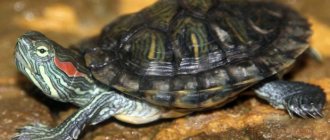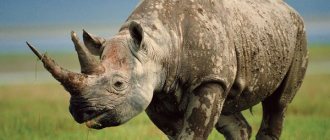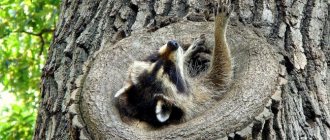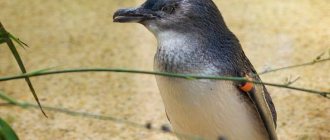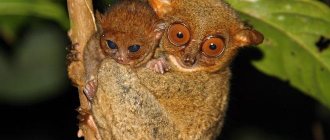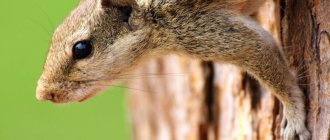Chameleons are a large family from the order of scaly reptiles. Since these reptiles spend most of their lives on the branches of trees and shrubs, they are often called tree lizards. Unpretentious and phlegmatic reptiles tolerate captivity well, so they are suitable for keeping as pets.
Everyone knows that a chameleon changes color, but this is not the only interesting feature of the animal.
Characteristics and description
Chameleons are classified as predatory reptiles. They are active during daylight hours and rest at night, hiding in shelters in trees or in burrows. During the hunt, lizards look for a convenient place for an ambush and freeze, remaining in one position for several hours and waiting for prey.
The chameleon has good eyesight. The eyes can move uncoordinatedly in different directions, so he sees everything that is happening around him without changing the position of his head. Lizards do not have an eardrum, but are able to detect sound vibrations with a frequency of 200-650 Hz.
Adaptation to the habitat in arboreal lizards is expressed in the presence of a prehensile tail capable of supporting the weight of the animal, as well as in the arrangement of the toes: they form a kind of claw from two fused groups of two and three toes opposed to each other.
Information about the chameleon would be incomplete without indicating the weight and size of the animal. Among arboreal lizards there are both fairly large specimens and small dwarf varieties. The weight of a chameleon can vary from 30 grams to 2 kg. The sizes of adults of various species are presented below.
| Name | Body length , cm |
| Chameleon Ostaleti | 70 |
| Yemen chameleon | 60 |
| Chameleon Globifer | 38 |
| Common chameleon | 30 |
| Two striped chameleon | 25 |
| Marshall's pygmy chameleon | 7 |
What does it look like
The description of the animal has the following features:
- the body is elongated, laterally compressed, covered with lumpy skin;
- the head in the front part is narrowed, many species have growths in the form of ridges, horns, pearl placers;
- the mouth is large, there are many small sharp teeth in the oral cavity;
- the paws are thin, each with five fingers, one of them has a sharp claw, with the help of which the animal is held in the trees;
- the tail is long, curled into a ring.
How and why a chameleon changes color
There is a strong belief that tree lizards change color to adapt to their environment. In fact, the chameleon is not at all a master of camouflage, since the change in shades of the skin is a reaction to the emotional state of the animal, temperature and light level. In addition, color change is a unique way of communication between individuals of the same species.
The ability to change colors and patterns is provided by special cells - chromatophores. Their plasma contains grains of several types of pigments that absorb and reflect different parts of the solar spectrum. Pigment cells form layers, each of which contains chromatophores of the same type.
The mechanism for changing color is as follows:
- under the influence of nerve impulses, pigment grains are distributed throughout the cell or shifted to the center;
- when the grains in the cells of the upper layer are shifted to the center, the lower layer becomes visible through them, reflecting another part of the spectrum.
The appearance of a chameleon can change completely or partially, while the variety of color variations depends on the type of animal and its habitat.
Language
The chameleon is a dangerous and precise killer that hunts in a very unusual way: at the sight of the victim, the lizard, which continues to remain motionless, sharply throws its tongue forward and captures the prey.
A chameleon's tongue may well be considered another limb. It is well developed and has a special structure:
- the main part is thinner, the tip is slightly thickened and can change shape during contact with prey;
- the tongue contains salivary glands, the viscosity of their secretion is 400 times greater than the viscosity of human saliva;
- in the lower part there are two muscles that push the tongue forward.
The chameleon's tongue is longer than its body, so when returning to its original position it curls into a spiral.
When studying various species of lizards, it was found that when the tongue is thrown out, its tip reaches speeds of up to 100 km/h in just a hundredth of a second. The length of the chameleon's tongue is 2 times longer than the body length in larger species and 2.5 times in small ones.
Character and lifestyle of a chameleon
Chameleons spend almost their entire lives in tree branches. They only come down during the mating season. It is in this environment that it is easier for the chameleon to maintain camouflage. It is difficult to move on the ground with clawed paws. That's why they have a swaying gait. Only the presence of several points of support, including a grasping tail, allows animals to feel great in the thickets.
Chameleons are active during the daytime. They move little. They prefer to be in one place, wrapping their tail and paws around a tree branch. But they run and jump quite quickly if necessary. Birds of prey and mammals, large lizards and some types of snakes can pose a danger to the chameleon. When it sees an enemy, the reptile inflates like a balloon and its color changes.
As it exhales, the chameleon begins to snort and hiss, trying to scare the enemy. It may even bite, but since the animal has weak teeth, it does not cause serious wounds. Now many people have a desire to buy a chameleon animal . At home they are kept in a terrarium. A chameleon as a pet will not cause much trouble if you create comfortable conditions for it. It is better to consult a specialist on this issue.
What types of chameleons are there: names and photos
In the biological classification there are more than 200 species of arboreal lizards. Let us dwell in more detail on the most interesting representatives of the family.
Common chameleon
The most widespread type. The color is dominated by yellow, brown and green shades. Some species are able to live in desert areas, using the burrows of other animals as shelter.
Helmeted Yemen chameleon
The species Chamaeleo calyptratus is endemic to the southern Arabian Peninsula. You can distinguish it from other members of the family by the high crest on its head and curved back. The color is dominated by yellow and green. The species is characterized by the presence of alternating transverse stripes. It is distinguished by its rapid adaptation to captivity, and regularly produces numerous offspring.
Chameleon Parsoni
The species Calumma parsonii can only be found on the island of Madagascar. The lizards have characteristic bright growths on the forehead and are distinguished by a very beautiful variegated color: the upper part of the back is yellow, the sea-green body has transverse dark stripes and spots.
Panther chameleon
Features of the Furcifer pardalis species include age-related color changes. Juveniles are painted an inconspicuous gray color, and when they reach sexual maturity, their skin becomes brightly colored with many spots and stripes.
Jackson's horned chameleon
The main characteristic feature of the species is the presence of horns on the head of adult individuals: the male has three, and the female has one. Reptiles are quite aggressive in nature, and often engage in fights that end in serious injuries. The color is dominated by yellow, green and brown shades.
Madagascar
Medium-sized individuals of the short-horned chameleon Oshagnesi have two large processes on the front of the head. The coloring is dominated by gray and green shades; there are yellow spots on the head and paws. Suitable for keeping in terrariums.
Carpet
The species received its name for its variegated spotted color, which combines orange, blue, yellow, dark blue and red shades. On the head of the animal there is a crest divided into two parts, the back is strongly curved.
VARAN
What unusual chameleons look like
Yemeni
Large in size. Males are green, covered on the sides with yellow or red streaks. There is a huge comb-like growth on the head.
And the tail part is decorated with yellow-green stripes.
Panther
It is distinguished by its characteristic coloring influenced by the climatic features of the area of distribution. Reaches a length of 30 to 40 cm.
Carpet
Named due to its amazing multi-colored color, combining longitudinal lines and spotted ovals on the sides. Quite active, lives in Madagascar.
Four-horned
Found in the mountains of Cameroon. It has a long crest on the abdomen and along the dorsal spine. Body length from 25 to 37 cm.
How do they reproduce?
Chameleons lead a predominantly solitary lifestyle and can briefly pair up only during the breeding season, which usually occurs in late autumn.
The formation of eggs in the female’s body lasts for 4-6 weeks. Before laying eggs, she becomes restless and aggressive. Chameleons lay their clutches on the ground, looking for secluded places and holes. One clutch can contain up to several dozen leathery eggs.
Oviparous species of lizards cannot be called caring parents: after laying eggs, the female immediately forgets about them. If the clutch does not become prey for snakes or birds, after 5-9 months the cubs are born, which immediately after hatching hide in dense vegetation and begin to hunt.
In the few ovoviviparous arboreal reptiles, females do not lay eggs, but carry them within themselves until the offspring appear. The female is capable of bearing 10-15 cubs at a time. In such cases, chameleons are born helpless. They stay with the female for some time and live on her back.
Reproduction and lifespan
Most chameleons are oviparous. After fertilization, the female carries the eggs for up to two months. Some time before laying eggs, the expectant mother shows extreme anxiety and aggression. They develop bright colors and do not allow males to approach them.
The expectant mother descends to the ground and looks for a place to dig a hole and lay eggs. Each species has a different number of eggs and can range from 10 to 60. There can be about three clutches throughout the year. The development of the embryo can take from five months to two years (also depending on the species).
The babies are born independent and, as soon as they hatch, run to the plants to hide from enemies. If the male is absent, the female may lay "fat" eggs, from which the young will not hatch. They disappear after a few days.
The birth principle of viviparous chameleons is not very different from oviparous chameleons. The difference is that the female carries the eggs inside herself until the babies are born. In this case, up to 20 children may appear. Chameleons do not raise their offspring.
The lifespan of a chameleon can be up to 9 years. Females live much shorter lives, as their health is undermined by pregnancy. The price of chameleons is not very high. However, the unusual nature of the animal, its charming appearance and funny habits can please the most picky fauna lover.
Where do they live?
The range of modern chameleon species is limited to the territory of Africa and the southern regions of the Indian and Arabian Peninsulas. Some varieties are found in the south of Western Europe. Most of the known species of chameleons live on the island of Madagascar. Some researchers believe that this is where the historical homeland of arboreal reptiles is located.
Where live
For most species, the natural habitat is the dense branches of trees and shrubs of tropical forests or savannas.
Pygmy chameleons live on the forest floor, hiding in grass, leaf litter and under low-lying branches. There are several terrestrial species in the family that live in steppes and desert regions where there is little or no vegetation. Natural shelters or burrows dug by rodents or other animals provide protection from scorching heat and predators for reptiles.
TRITON
Appearance and features
Some varieties of such reptiles grow up to 30 cm in length, while there are species whose body length reaches half a meter, or even more. There are species whose sizes range from 3 to 5 cm. The head of the reptile resembles a helmet, while the occipital region is somewhat raised. Similar representatives of this family are characterized by the presence of ridges of various sizes, tubercles, as well as sharp, elongated horns. As a rule, such formations on the body are more characteristic of males, while in females they are in their infancy.
The limbs of chameleons are relatively long and perfectly adapted for life in trees. The animal’s fingers are fused in 2 or 3 pieces, and they are directed inward, which creates the appearance of a kind of “claws”. Such “claws” securely grasp tree branches. The tail is quite thick at the very base, but tapers noticeably towards the end. It basically hangs down and is twisted into a spiral. It also helps the animal stay on tree branches, as it can wrap itself around the branches. Unfortunately, the lost tail of a chameleon cannot be restored, like some other representatives of this family.
Chameleons have a unique eye structure. The eyelids of this animal are fused and constantly cover the eyes, but there are holes for the pupils. Both eyes can rotate in any direction, independently of each other.
Interesting moment! In the normal position, the tongue is held in the lower jaw area by a special bone. If the prey is relatively large, then the chameleon grabs it with its mouth.
While waiting for its prey, a chameleon can sit motionless on a branch for a long time. If an insect appears nearby, the animal “shoots” at it with its tongue equipped with a suction cup. The chameleon has both a middle and an outer ear, and it detects sound waves in the range from 250 to 650 Hertz.
What do chameleons eat in the wild?
The main diet of lizards consists of a variety of insects and their larvae. Representatives of giant species often eat small rodents, reptiles and even birds.
Chameleons are predators, but can also eat plant foods. They eat soft vegetables, fruits, and plant leaves. In this way, animals replenish the reserves of moisture and vitamins in the body.
Arboreal reptiles are not voracious and are able to survive on small amounts of food.
Interesting chameleons: photos and facts
Interesting photos of chameleons in nature - great luck! See for yourself.
This is interesting!
- The diurnal lifestyle of lizards is explained by the elementary inability for a sleeping individual to maintain control over camouflage. And the acquired pallor of the skin can give them away to predators.
- Representatives of the male half turn black from experiences of being rejected during mating games, or having suffered a fiasco in a battle with an opponent.
- The impression of thinness of these animals is deceptive. They just eat very little compared to their brothers.
- The Spaniards keep reptiles in their homes and retail outlets to catch pesky flies and other insects.
Who eats chameleons in the wild?
Tree lizards have no protection from predators. In case of danger, they are able to change color and inflate, trying to appear larger. If the chameleon sees that the measures it has taken have been ineffective, it tries to hide by deftly jumping from branch to branch.
Natural enemies of arboreal reptiles include birds, snakes, larger reptiles, and some mammalian predators.
AXOLOTL
Four-horned chameleon
The four-horned chameleon, so named because of the four horns on its head, is also of interest. Moreover, male four-horned chameleons most often have three horns, and the fourth may simply not be developed. These animals live in the mountain forests of Cameroon, in its most inaccessible places. Adults usually reach sizes of 25-37cm. They are not very aggressive towards chameleons of their own species, or towards people. They live in captivity for up to 5 years.
Male Yemen chameleon (Chamaeleo calyptratus) in natural coloring.
The four-horned chameleon has a rather unusual appearance: starting from the lower jaw, the chameleon has a long abdominal ridge, which becomes smaller closer to the tail, and a particularly large ridge on the back generally looks like a fin. Females are usually 5-7 cm smaller than males and have neither horns nor high crests. The main color shades of the four-horned chameleon are blue, dark green and black. The clutch of this chameleon consists of 8-14 eggs, small chameleons hatch after 5-6 months of incubation.
The female Yemen chameleon does not have a “helmet”. On the body of the actively “greening” female, traces of the original “calm” coloring are visible - small specks and very pale stripes.
Interesting facts about chameleons
- The chameleon family includes the genus Brookesia, which includes up to 30 species of small chameleons. All of them are endemic to the island of Madagascar and nearby islands. Brookesia minor belongs to the genus - the smallest chameleon, the length of which does not exceed 4 cm.
- More than 70 species of chameleons are included in the International Red Book, almost 40 of them have been assigned the status of “endangered species”.
- Studies of the remains of chameleon skeletons found during excavations indicate that the first ancestors of these reptiles appeared about 100 million years ago.
- The chameleon is able to distinguish poisonous insects and does not eat them even in the absence of prey for a long time.
- Lizards are capable of turning completely black. In this way they scare away predators. Also, males who fail in a fight with a stronger opponent or are rejected by a female can acquire a mourning color.
Yemen chameleon
Its size is one of the largest among its relatives: the body length of the Yemeni chameleon is about half a meter. Males have yellow spots with a reddish edge on the sides against a green background. The head is decorated with a chic large crest 7-8 cm in length (which is quite a lot compared to the dimensions of the body). The tail is also covered with yellow-green stripes. Males differ from females mainly by the so-called “spurs” - triangular protrusions on their paws.
African dwarf chameleon (Rhampholeon temporalis).
The habitat is already visible from the very name of the species: it comes from the name of the state of Yemen. They live either in the high mountains of the Arabian Peninsula or in hot areas in eastern Saudi Arabia. Reproduction occurs when the individual reaches one year. He, like all chameleons, feeds on insects. Like its relatives, the Yemen chameleon is capable of changing body color.
The body of chameleons is flattened from the sides, the back is noticeably arched and decorated with a crest, which is why chameleons give the impression of being eternally hunched over.
